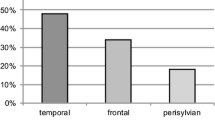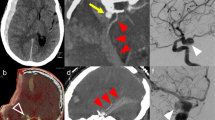Abstract
Purpose
The combination of ruptured aneurysms with acute subdural hematomas (aSDHs) is a rare presentation. Patients with aSDH associated with aneurysmal bleeding represent a subgroup within the spectrum of aneurysmatic hemorrhage. We summarize the clinical characteristics, diagnostic evaluation, and management of a series of cases presenting with aSDH associated with aneurysmal subarachnoid hemorrhage (SAH).
Methods
Medical records and surgical reports of 743 consecutive patients admitted to our institution with SAH from January 1995 to December 2007 were screened to detect cases of associated aSDH. Admission evaluations included the Glasgow Coma Scale (GCS) and the subarachnoid grade of the World Federation of Neurosurgical Societies (WFNS). Radiological assessment included computer tomography (CT) scan, CT angiography (CTA), and digital subtraction angiography (DSA). The presence and volume of SAH, intracerebral hemorrhage (ICH), and aSDH were documented. Outcome was measured in terms of Glasgow Outcome Scale (GOS) and modified Rankin Scale (mRS) at 4–8 months.
Results
A total of seven cases (0.9%) presenting with aSDH (mean width: 11.2 mm ± 4.8 mm, range: 5–20 mm) attributable to SAH were documented. Three of these patients were admitted with a suspicion of trauma. Five patients presented with WFNS grade 5, one patient with WFNS grade 3, and one patient with WFNS grade 1. All patients underwent evacuation of the aSDH. In four patients, surgical obliteration of the aneurysm was achieved in the same procedure. Two patients underwent delayed occlusion of the aneurysm: one by coiling and one by clipping. Three of the seven patients recovered completely from their neurological deficits (GOS 5, mRS 0–1), three recovered with mild disability (GOS 4, mRS 2–3), and one died within 8 h after the decompressive procedure.
Conclusions
The incidence of aSDH associated with SAH is low. Most of the patients with aSDH due to a ruptured aneurysm present in exceptionally poor neurological condition. Nevertheless, rapid surgical treatment of the hematoma and aneurysm obliteration can lead to a favorable outcome. Routine CTA should be performed in all patients presenting with an aSDH associated with SAH and no clear history of trauma.

Similar content being viewed by others
References
Barnett HJ (1969) Some clinical features of intracranial aneurysms. Clin Neurosurg 16:43–72
Barton E, Tudor J (1982) Subdural haematoma in association with intracranialaneurysm. Neuroradiology 23:157–160
Beck J, Raabe A, Szelenyi A, Berkefeld J, Gerlach R, Setzer M, Seifert V (2006) Sentinel headache and the risk of rebleeding after aneurysmal subarachnoid hemorrhage. Stroke 37:2733–2737
Bonita R, Beaglehole R (1988) Modification of Rankin Scale: recovery of motor function after stroke. Stroke 19:1497–1500
Clarke E, Walton JN (1953) Subdural haematoma complicating intracranial aneurysm and angioma. Brain 76:378–404
Fisher CM, Kistler JP, Davis JM (1980) Relation of cerebral vasospasm to subarachnoid hemorrhage visualized by computerized tomographic scanning. Neurosurgery 6:1–9
Fox J (1983) Intracranial aneurysms. Springer, New York, pp 199–203
Freytag E (1966) Fatal rupture of intracranial aneurysms. Survey of 250 medicolegal cases. Arch Pathol 81:418–424
Hasse K (1855) Die Krankheiten des Nervensystems. In: Virchow R (ed) Handbuch der speziellen Pathologie und Therapie, vol IV/1. Enke, Erlangen, p 404
Hatayama T, Shima T, Okada Y, Nishida M, Yamane K, Okita S, Yoshida A, Noae Y, Shiga N (1994) Ruptured distal anterior cerebral artery aneurysms presenting with acute subdural hematoma: report of two cases. No Shinkei Geka 22:577–582
Hori E, Ogiichi T, Hayashi N, Kuwayama N, Endo S (2005) Case report: acute subdural hematoma due to angiographically unvisualized ruptured aneurysm. Surg Neurol 64:144–146
Ishibashi A, Yokokura Y, Sakamoto M (1997) Acute subdural hematoma without subarachnoid hemorrhage due to ruptured intracranial aneurysm—case report. Neurol Med Chir (Tokyo) 37:533–537
Jennett B, Bond M (1975) Assessment of outcome after severe brain damage. Lancet 1:480–484
Kamiya K, Inagawa T, Yamamoto M, Monden S (1991) Subdural hematoma due to ruptured intracranial aneurysm. Neurol Med Chir (Tokyo) 31:82–86
Koerbel A, Ernemann U, Freudenstein D (2005) Acute subdural haematoma without s ubarachnoid haemorrhage caused by rupture of an internal carotid artery bifurcation aneurysm: case report and review of literature. Br J Radiol 78:646–650
Koyama S (2000) Giant aneurysm of the pericallosal artery causing acute subdural hematoma—case report. Neurol Med Chir (Tokyo) 40:268–271
Nonaka Y, Kusumoto M, Mori K, Maeda M (2000) Pure acute subdural haematoma without subarachnoid haemorrhage caused by rupture of internal carotid artery aneurysm. Acta Neurochir (Wien) 142:941–944
O’Leary PM, Sweeny PJ (1986) Ruptured intracerebral aneurysm resulting in a subdural hematoma. Ann Emerg Med 15:944–946
O’Sullivan MG, Whyman M, Steers JW, Whittle IR, Miller JD (1994) Acute subdural haematoma secondary to ruptured intracranial aneurysm: diagnosis and management. Br J Neurosurg 8:439–445
Ohkuma H, Shimamura N, Fujita S, Suzuki S (2003) Acute subdural hematoma caused by aneurysmal rupture: incidence and clinical features. Cerebrovasc Dis 16:171–173
Pasqualin A, Bazzan A, Cavazzani P, Scienza R, Licata C, Da Pian R (1986) Intracranial hematomas following aneurysmal rupture: experience with 309 cases. Surg Neurol 25:6–17
Russeger L, Twerdy K (1986) Subdural hematoma following rupture of an aneurysm. Zentralbl Neurochir 47:226–243
Sachs E, Bernat JL (1978) Recovery from acute subdural hematoma and uncal herniation due to ruptured intracranial aneurysm. Neurosurgery 3:66–67
Strang R, Tovi D, Hugosson R (1961) Subdural hematomas resulting from the rupture of intracranial arterial aneurysm. Acta Chir Scand 121:345–350
Teasdale G, Jennett B (1974) Assessment of coma and impaired consciousness. A practical scale. Lancet 2:81–84
Teasdale GM, Drake CG, Hunt W, Kassell N, Sano K, Pertuiset B, De Villiers JC (1988) A universal subarachnoid hemorrhage scale: report of a committee of the World Federation of Neurosurgical Societies. J Neurol Neurosurg Psychiatry 51:1457
Weir B, Myles T, Kahn M, Maroun F, Malloy D, Benoit B, McDermott M, Cochrane D, Mohr G, Ferguson G et al (1984) Management of acute subdural hematomas from aneurysmal rupture. Can J Neurol Sci 11:371–376
Westermaier T, Eriskat J, Kunze E, Gunthner-Lengsfeld T, Vince GH, Roosen K (2007) Clinical features, treatment, and prognosis of patients with acute subdural hematomas presenting in critical condition. Neurosurgery 61:482–487 discussion 487–488
Yasui T, Komiyama M, Kishi H, Yagura H, Fu Y, Nagata Y, Tamura K (1995) Angiographic extravasation of contrast medium in acute “spontaneous” subdural hematoma. Surg Neurol 43:61–67
Author information
Authors and Affiliations
Corresponding author
Additional information
Comment
In non-comatose patients with aSDHs associated with SAH, it is of utmost importance to get accurate clinical information regarding the symptom onset and co-morbidity, including possible anticoagulation therapy. Small amounts of blood may be seen relatively often in the subdural space in patients with massive SAH, but large hematomas necessitating removal per se are rare. The history of typical symptoms of SAH together with blood is SA and subdural space with no trauma history naturally indicates aneurysmal origin in most cases, and for anatomical reasons ICA-PCom being the most common in the present series and literature. CTA is replacing DSA rapidly in primary aneurysm diagnostics in many centers as a non-invasive and quick method. As the authors conclude, it should be performed with a low threshold to exclude aneurysmal origin when in doubt, especially in comatose patients presenting with aSDH associated with SAH, possibly with no previous medical history available on admission.
Mika Niemelä
Juha Hernesniemi
Helsinki, Finland
Rights and permissions
About this article
Cite this article
Marbacher, S., Fandino, J. & Lukes, A. Acute subdural hematoma from ruptured cerebral aneurysm. Acta Neurochir 152, 501–507 (2010). https://doi.org/10.1007/s00701-009-0521-0
Received:
Accepted:
Published:
Issue Date:
DOI: https://doi.org/10.1007/s00701-009-0521-0




